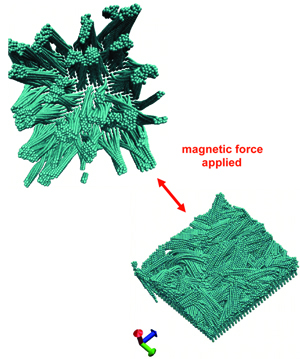
Professor Buehler of IRG-II has employed atomistic-based multiscale simulations to theoretically demonstrate the concept of “mechanomutability," i.e. the capability of a material to change its mechanical properties reversibly in response to an external stimulus.
The first model system studied was a surface-anchored array of carbon nanotubes which, under the application of an external magnetic field, undergoes dramatic conformational changes leading to variations in spatial patterning. This phenomenon results in a contact stiffness that can be changed reversibly from ~ 73 MPa to 910 MPa. Hence, Buehler demonstrated that by applying an appropriate external field, it is possible to induce and control a dramatic mechanical response in such a nanostructured system.
Mechanomutable materials have many potential applications, e.g. control of cellular behavior, modulation of protein adsorption, the creation of nanoscale motors that perform mechanical work, tunable vibration absorption, and high spatial sensitivity variable sensors (e.g. localized impacts, liquid pressure, etc.) to name a few.
Figure Left. In the absence of an external magnetic force the carbon nanotubes bundle together in a spatially heterogeneous pattern due to van der Waals adhesion.
Figure Right. Upon application of a magnetic force, a dramatic change in the patterned nanostructure takes place with the carbon nanotubes collapsing towards the surface in a more homogeneous structure.
This research was partially funded by the NSF MRSEC Program (award DMR-08-19762).